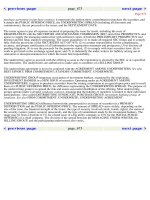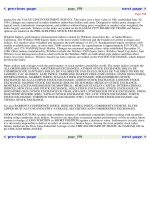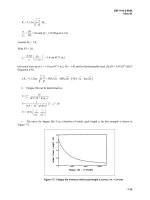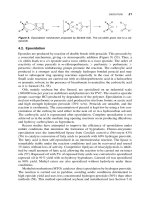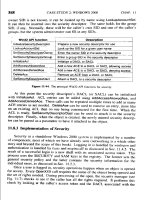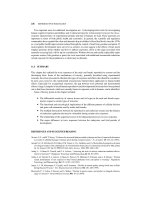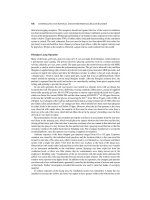PC Upgrade and Repair Bible Desktop Edition phần 10 ppsx
Bạn đang xem bản rút gọn của tài liệu. Xem và tải ngay bản đầy đủ của tài liệu tại đây (564.93 KB, 42 trang )
IRC Internet Relay Chat. An Internet service that allows multiple users to con-
verse in real time on different subjects (each subject is called a channel).
Similar to instant messaging, but non-proprietary.
IRQ Interrupt request. The identifier of a signal that a device can send to the
processor to indicate it needs service.
ISA Industry Standard Architecture. The bus used in the original IBM PC. Now
obsolete, replaced by PCI.
ISP Internet service provider. A company that sells dial-up (or other) access
to the Internet.
ITU International Telecommunications Union.
ITU-TSS International Telecommunications Union-Telecommunications
Standardization Sector.
Kbps Kilobits per second (multiples of 1,024 bits per second).
keys Notches on a memory module or other connector that prevent it from
being installed incorrectly or into an incompatible system.
kilobit Approximately 1,000 bits: 1 bit × 2
10
(that is, 1,024 bits).
kilobyte Approximately 1,000 bytes: 1 byte × 2
10
(that is, 1,024 bytes).
LAN Local area network. A data communications network confined to a lim-
ited geographic area, with moderate to high data rates (10 to 1,000 Mbps, for
example). The area served may consist of a single building or a campus-type
arrangement. A LAN is typically owned by its users, includes some type of
switching technology, and does not use common carrier circuits (although it
may have gateways or bridges to other public or private networks).
latency Delay between two events, such as the time delay between when the
first bit of a packet is received and the last bit is forwarded.
LCD Liquid crystal display. Two thin transparent surfaces (usually glass), with
grooves full of a liquid crystal substance that are then polarized and electri-
cally charged to reorient the crystal and selectively allow light to pass
through.
leakage Undesirable conductive paths in components, subsystems, and sys-
tems; also the current through such paths.
LED Light-emitting diode.
Line In A connector on audio equipment to which a device such as a CD
player or tape cassette player may be attached. See also Line Out.
Line Out A connector on audio equipment to which audio components such
as stereo speakers can be attached. See also Line In.
434 Glossary
link A physical connection between two nodes in a network. It can consist of
a data communication circuit or a direct channel (cable) connection.
LISTSERV An automated mailing list distribution system. LISTSERVs are organ-
ized by topic of interest and maintained on an ad hoc basis.
local loop The line from a telephone customer’s premises to the telephone
company CO (central office).
MAC Media Access Control. A method of controlling access to a transmission
medium, for example, Ethernet.
master/slave Used to refer to the relationship of devices (especially ATA disk
drives) on a communications channel. Discouraged as offensive in Los Angeles.
Mb Megabit.
MB Megabyte.
Mbps Megabits per second (one million bits per second), a measurement of
data transmission rate.
MBps Megabytes per second (one million bytes per second).
megabit Approximately one million bits: 1 bit × 1,024
2
(that is, 1,048,576 bits).
megabyte Approximately one million bytes: 1 byte × 1,024
2
(that is, 1,048,576
bytes).
memory A computer system’s high speed, random access storage. Memory
stores data electronically in integrated circuits.
memory bank A unit of memory in a computer, the size of which is determined
by the computer’s CPU.
memory cycle The minimum amount of time required for a memory to com-
plete a cycle such as read, write, read/write, or read/modify/write.
memory types See DRAM, EPROM, PROM, RAM, ROM, and SRAM.
microATX A form factor specifying the size and layout of desktop computers.
The specification extends to the definition of the power supply and its inter-
face to the PC.
micron A unit of measure equivalent to one-millionth of a meter; synonymous
with micrometer.
MIDI Musical Instrument Digital Interface. A standard that allows for the
exchange of data between two music synthesizers or a synthesizer and a
computer.
Glossary 435
MIME Multipurpose Internet Mail Extensions. An Internet standard for con-
verting multiple file formats to ASCII text prior to transmission in e-mail.
MIPS Million instructions per second. A measurement of processor speed.
MMC Multimedia Card. One of several flash memory form factors used for
storage in cameras and other portable electronic devices.
modulation A process by which signal characteristics are transformed to rep-
resent information.
motherboard Also known as logic board, main board, or system board; your
computer’s main electronics board, which in most cases either contains all
CPU, memory, and I/O functions or has expansion slots that support them.
MPEG Moving Picture Experts Group. MPEG-1, -2, and -4 are types of lossy
data compression for storage and playback of combined video and audio data.
MPEG-3 (MP3) is a standard for lossy audio compression.
MTBF Mean time between failures.
MTTF Mean time to failure.
MTTR Mean time to repair.
MTU Maximum transmission unit. The largest possible unit of data that can be
sent on a given network medium.
Multilink PPP A variant of PPP for channel aggregation, used by connections
over multiple 56 Kbps dial-up lines. Outlined in IETF RFC 1717.
multimedia A combination of media used for entertainment, education, and
communication.
multitasking The execution of commands in such a way that more than one
command is in progress at the same time. See also hyperthreading.
nano Literally, one-billionth (10
–9
).
nanometer A measurement equal to one-billionth of a meter. The shorter-
wavelength thinner-beam red laser incorporated in DVD players measures 650
nanometers, compared to 780 nanometers for a conventional CD player laser.
nanosecond (ns) One-billionth of a second. Memory data access times are
measured in nanoseconds. For example, memory access times for typical 30-
and 72-pin SIMM modules range from 60 to 100 nanoseconds. Light travels
approximately 8 inches in 1 nanosecond.
NetBIOS Network Basic Input/Output System. Standard interface to networks
on IBM PC and compatible systems.
436 Glossary
network layer The protocol layer responsible for routing, switching, and sub-
network access.
network topology The arrangement of nodes usually forming a star, ring, tree,
or bus pattern.
NFS Network File System.
nibble Usually 4 bits or half a byte.
NIC Network interface card.
NNTP Network News Transfer Protocol. The Internet protocol supporting
Usenet newsgroups.
node Any device connected to a network, including servers and workstations.
nonvolatile memory Memory that retains information if power is removed
and then reapplied.
ns See nanosecond.
NTFS NT file system. This alternative to the DOS FAT file system is used by
Windows NT, 2000, and XP to provide increased performance and enhanced
security.
NTSC National Television Standards Committee. They devised the NTSC televi-
sion broadcast system in 1953. Supports vertical resolution of 525 horizontal
lines stacked on top of each other. There are 59.94 fields displayed per second.
A field is a set of even lines, or odd lines. The odd and even fields are displayed
sequentially, interlacing to form the full frame. One full frame is displayed every
1
⁄30 of a second.
open source Computer software for which the source code is made available
for public examination and modification. See
www.opensource.org.
operating system Software controlling the overall operation of a multipurpose
computer system, including memory allocation, input and output, interrupt
processing, and scheduling.
OSI Open Systems Interconnection. See OSI Reference Model.
OSI Reference Model A seven-layer network architecture model of data com-
munication protocols developed by ISO and CCITT. Each layer specifies partic-
ular network functions such as addressing, flow control, error control,
encapsulation, and reliable message transfer.
packet A collection of bits comprising data and control information formatted
for transmission from one node to another.
packet filtering Examination of en-route packets by a router to decide
whether or not to allow transmission of each packet.
Glossary 437
packet switching A type of data transfer that occupies a communication link
only during the time of actual data transmission. Messages are split into pack-
ets and reassembled at the receiving end of the communication link.
packetization Information that, instead of being transported as a constant
stream of information, is transported as blocks.
packet-switched network A network in which data is transmitted in units
called packets. The packets can be routed individually over the best available
network connection and reassembled to form a complete message at the
destination.
page One unit of information from a Web server. Also, the bits that can be
accessed from one memory row address.
page mode A now-obsolete memory mode in which if RAS is kept low and the
DRAM is given a column address without being given a new row address, the
chip will remember which row it was on the last time and automatically stay
on that row.
PAL Page Alternation Line. A European standard for television signals having
625 horizontal lines of vertical resolution. Fifty interlaced fields are displayed
per second, or 25 frames per second.
palette In 256-color modes, the palette defines the range of colors you can
display simultaneously. Also, the hardware in a video board that stores the
available colors.
parity A method of data-integrity checking that adds a single bit to each unit
(typically a byte) of data. In odd parity mode, the parity bit is set if the checked
data contains an odd number of ones; in even parity mode, the parity bit is set
if the checked data contains an even number of ones.
parity bit A bit added to a group of bits to detect the presence of an error.
patch cable An Ethernet cable with male RJ-45 connectors on either end.
PCI Peripheral Component Interconnect. A type of high-speed computer bus.
PCI Express A high-speed computer bus intended to replace PCI. PCI Express
typically uses fewer data lines and can operate at higher speeds and over
longer distances than PCI.
PCMCIA Personal Computer Memory Card International Association. Now
called PC Card. A standard for small, flat credit-card-sized devices used in
notebook computers.
peer-to-peer communications A type of communications and data exchange
between peer entities (for example, two user PCs) on two or more networks.
Contrast with client/server.
peripheral A device installed on a computer system.
438 Glossary
p-frame MPEG-2 frames constructed by analyzing previous frames and esti-
mating where objects will be in the next frame.
ping A program used to test reachability of destinations by sending them an
ICMP echo request and waiting for a reply. Ping is also used as a verb: “Ping
the site to see if it is available.”
PIO Programmed Input/Output. A method of data transfer in which the host
microprocessor transfers data to and from memory via the computer’s I/O
ports. PIO is not as fast as direct memory access (DMA) and imposes a signifi-
cant load on the processor.
pits and lands Marks on the surface of a CD-ROM or DVD disc that are read by
a laser as the series of ones and zeros.
pixel A single dot on a display. Derived from the words picture and element.
pixel shader A programmable graphics operation implemented on the video
card to create custom lighting, coloring, and other effects on a per-pixel basis.
Plug and Play A standard intended to overcome the configuration problems
inherent in the ISA bus by letting adapters self-configure and automatically
resolve system resources such as interrupts (IRQ), DMA, port addresses, and
BIOS addresses. Largely obsolete per se with the advent of the PCI bus, but co-
opted to refer to any device that automatically configures itself (for example,
PCI, USB).
polling A method of controlling the sequence of transmission by devices on a
multipoint line by requiring each device to wait until the controlling processor
requests it to transmit.
POP Post Office Protocol. An Internet standard protocol for reading mail from
a server. The commonly used version is POP3.
port I/O address The number of the I/O port through which the processor
communicates with a peripheral.
POST Power-On Self-Test, a set of diagnostic routines that run when a com-
puter is first turned on.
POTS Plain Old Telephone Service. Really. POTS refers to the existing analog
telephone lines, and is the universal term in the telecommunications industry.
power down To turn the system’s power off.
power up To turn the system’s power on.
PPP Point-to-Point Protocol. Provides Internet protocol connections over
serial circuits.
PROM Programmable read-only memory. A version of a ROM that is program-
mable once using special devices.
Glossary 439
protocol A standardized set of rules that specify the format, timing, sequenc-
ing, and/or error checking for data transmissions.
PTT Public Telephone and Telegraph. A generic term for European telephone
companies. Most are (currently) state owned and operated. The Deutsche
Bundespost is one example of a PTT.
pulse dialing Dialing a telephone line as if using the older-style rotary dial
wheel.
QoS Quality of service. Describes the delay, throughput, bandwidth, and other
performance characteristics of a network connection.
RAM Random access memory. A configuration of memory cells that holds
data for processing by a computer’s CPU. The term random access means the
CPU can retrieve data from any individual location at any time.
Rambus Rambus DRAM is a memory standard capable of transferring 1.6 GB
per second.
RAS Row address strobe. The signal that tells the DRAM to accept the given
address as a row address. Used with CAS and a column address to select a bit
within the DRAM.
refresh An electrical process used to maintain data stored in DRAM. The
process of refreshing electrical cells on a DRAM component is similar to that
of recharging batteries. Different DRAM components call for different refresh
methods; and some (such as SDRAM) perform refresh automatically.
refresh rate Also called vertical scan rate, the speed at which the screen is
repainted. Typically, color displays must be refreshed at 60 times per second
to avoid flicker. Also, a specification determined by the number of rows on a
DRAM component that must be refreshed.
register-level compatibility Complete compatibility at the hardware level
from the software point of view.
remote user A user who needs client access to a server over WAN links.
removability A feature where the media in a removable media disk drive,
or the entire drive, can be removed and then replaced while the computer
remains in operation, without causing problems to the hardware or operating
system.
repeater Used to extend the network topology, allowing a cable’s segments to
be lengthened beyond normal specification limits. See also hub.
RGB Red/green/blue, a color model typically used with monitors.
RISC Reduced instruction set computing. RISC chips, such as in the PowerPC
processor used in Apple computers, implement simpler instructions than CISC
chips, such as the x86 processors used in Windows machines.
440 Glossary
RMA Return Material Authorization. Required if a customer desires to return
products to the manufacturer or supplier.
ROM Read-only memory. Generally a chip on a computer or I/O card with soft-
ware programmed inside of it that controls some function.
router A protocol-dependent device that connects subnetworks together. It is
useful in breaking down a very large network into smaller subnetworks.
routing protocol A protocol that accomplishes routing through the implemen-
tation of a specific routing algorithm.
routing table A table stored in a router or some other internetworking device
that keeps track of routes (and, in some cases, metrics associated with those
routes) to particular network destinations.
routing update A message sent from a router to indicate network reachability
and associated cost information. Routing updates are typically sent at regular
intervals and after a change in network topology.
row Part of the RAM array; a bit can be stored where a column and a row
intersect.
RS-232 A serial data transmission interface specification.
RTFM Read the Manual. Acronym suggesting a response to an easily answered
question. Sometimes found on automotive license plates.
sample A measurement of sound taken during a certain duration. In digital
recording, sampling means recording voltages that make a sound as a
sequence of numerical values representing the sound’s amplitude.
scan rate The frequency in hertz (Hz) at which the monitor is scanned hori-
zontally. Generally, the higher the scan rate, the higher the resolution.
SCSI Small Computer System Interface. A bus interface standard that defines
standard physical and electrical connections for devices. SCSI provides a
standard interface that enables many different kinds of devices, such as disk
drives, magneto-optical disks, CD-ROM drives, and tape drives to interface
with the host computer.
SD Secure digital. One of several flash memory form factors used for storage
in cameras and other portable electronic devices.
SDRAM Synchronous dynamic random access memory. Delivers bursts of
data at very high speeds using a synchronous interface.
sector The smallest storage access unit on a hard drive.
seek time The average time it takes for a hard drive to position its heads to a
specific sector.
Glossary 441
self-refresh A memory technology that enables SDRAM and some other mem-
ory technologies to refresh on its own, independent of the CPU or external
refresh circuitry.
semiconductor An element, such as silicon, that has intermediate electrical
conductivity between conductors and insulators, and in which conduction
takes place by means of holes and electrons.
Serial ATA A higher speed modification of the parallel ATA disk drive interface
to use fewer, faster wires between drive and PC.
serial interface An interface that requires serial transmission, or the transfer
of information in which the bits composing a character are sent sequentially.
Implies only a single transmission channel.
serial port A connection for a serial device like a mouse or a modem.
serial presence detect Indicator memory and pins on SIMMs and DIMMs that
provide size and timing information to the PC.
server A computer that provides shared resources, such as files, printers, and
servers, to the network.
SIMM Single in-line memory module. A printed circuit board with contacts and
memory devices that plugs into a computer’s memory socket.
SMTP Simple Mail Transfer Protocol. A protocol governing mail transmissions
defined in RFC 821. The associated message format descriptions are in RFC
822.
SNMP Simple Network Management Protocol. A network management system
for TCP/IP-based internets. One of the most egregious uses ever of the word
simple.
SODIMM Small outline dual inline memory module. A smaller and thinner ver-
sion of a standard DIMM. The small outline DIMM is about half the length of a
typical 72-pin SIMM. SODIMMs are typically used in laptop computers.
soft error In memory components, a correctable data error made by a device
not having anything physically wrong with it.
sound file Any file that holds sound data, including MIDI (.mid), wave (.wav),
and MPEG-3 (.mp3).
SPD See serial presence detect.
spoofing The use of a forged network source address to circumvent a firewall
or mask the sender.
SRAM Static random access memory. An integrated circuit similar to a DRAM
(dynamic random access memory) with the exception that the memory does
not need to be refreshed.
442 Glossary
star topology A network topology in which nodes are connected to a common
device such as a hub or concentrator.
storage A medium designed to hold data, such as a hard disk or CD-ROM.
storage capacity The limit to the amount of information that can be recorded
on any recording medium. In DVD, this varies from 4.7GB on a DVD-5 disc to
17GB on a DVD-18 disc.
STP Shielded twisted-pair. A common transmission medium that consists of
Receive (RX) and Transmit (TX) wires twisted together to reduce crosstalk.
The twisted-pair is shielded by a braided outer sheath.
surround sound A multiple-channel sound system that produces an audio
ambience similar to the cinema sound experience.
S-video An interface between video source and display providing higher-quality
signal transmission than the more common RCA video connector because it
separates the chrominance and luminance signal components.
switched Ethernet An Ethernet hub with integrated MAC layer bridging or
switching capability to provide each port with full LAN bandwidth; separate
transmissions can occur on each port of the switching hub, and the switch fil-
ters traffic according to the destination MAC address.
synchronous DRAM A DRAM technology that uses a clock to synchronize
signal input and output on a memory chip. The clock is coordinated with the
CPU clock so the timing of the memory chips and the timing of the CPU are
coordinated.
system board See motherboard.
T-connector A T-shaped device with two female and one male BNC connectors.
TCP Transmission Control Protocol. See also TCP/IP and IP.
TCP/IP Transmission Control Protocol/Internet Protocol. A set of protocols
developed by the U.S. Defense Department’s Advanced Research Projects
Agency (ARPA) during the early 1970s. Its intent was to develop ways to con-
nect different kinds of networks and computers.
Telnet The Internet standard protocol to connect to a computer as a remote
terminal.
timbre How the ear identifies and classifies sound. Example: The timbre of
the same note played by two different instruments (flute and tuba) will not
be the same.
topology The physical layout of a network. The principal LAN topologies are
bus, ring, and star.
Glossary 443
Trojan From Trojan horse. A malicious computer program posing as some
other program or image that, when run, compromises the security or integrity
of the PC.
true color Video displays and scanners operating with 24- or 32-bit color.
TWAIN A programming interface for scanners.
twisted-pair Cable consisting of two 18 to 24 AWG (American Wire Gauge)
solid copper strands twisted around each other. The twisting provides a meas-
ure of protection from electromagnetic and radio-frequency interference.
Twisted-pair cable typically contains multiple sets of paired wires. See STP
(shielded twisted-pair) and UTP (unshielded twisted-pair).
UART Universal Asynchronous Receiver/Transmitter chip, used to implement
the communications (COM) port in personal computers. Often integrated with
other functions in a single chip.
UDP User Datagram Protocol. An Internet standard protocol that allows an
application on one machine to send a datagram to an application program on
another machine. No confirmation of arrival is supplied, and order of arrival is
not guaranteed, so UDP is faster than TCP.
Universal Disk Format Defines data structures such as volumes, files, blocks,
sectors, CRCs, paths, records, allocation tables, partitions, character sets, time
stamps, and so forth; and methods for reading, writing, and other operations.
A format used on CD and DVD.
URL Uniform Resource Locator. A form of Internet address used by World
Wide Web browsers. Each browser-accessible resource on the Internet has a
unique URL (for example,
).
USB Universal Serial Bus. A high-speed serial interface expected to connect
keyboard, mouse, speakers, monitor, and other devices to your computer.
Usenet More commonly known as newsgroups, Usenet is a worldwide bulletin-
board system incorporating tens of thousands of groups on thousands of
servers around the world.
UTP Unshielded twisted-pair. Twisted-pair wiring like STP, but without the
outer shield. More common than STP. See also STP.
V.42bis The CCITT analog modem data compression standard. Provides a the-
oretical maximum of 4:1 compression, although 2:1 or less is more commonly
experienced.
VESA Video Electronics Standards Association. Sponsors efforts to set graph-
ics and video standards.
VGA Video Graphics Array. An analog display interface standard introduced
with the IBM PS/2 series.
444 Glossary
virus A malicious computer program that replicates itself from one PC to the
next through e-mail and infected removable disks.
WAAS Wide Area Augmentation System. A system of satellites and ground sta-
tions transmitting GPS signal corrections for better position accuracy.
WAN Wide area network. A network that uses common carrier–provided lines;
contrast with LAN.
warm boot Rebooting a computer without turning the power off (for example,
Ctrl+Alt+Del).
wave file A standard Microsoft file format for storing waveform audio data.
waveform A graph showing the amplitude of a sound over a particular inter-
val of time. Any portion of that interval is a sample.
worm A malicious computer program that replicates itself from one computer
to the next using security vulnerabilities reachable across networks.
write-back cache Cache memory that holds data written by the processor
until the bus and main memory have time to perform the write.
write-through cache Cache memory that executes processor writes to main
memory immediately, requiring the processor to wait until the operation is
complete.
WWW World Wide Web. The Internet-based hypertext system.
ZIF socket Zero-insertion force socket. A mechanism for a processor socket
supporting simple replacement of chips.
Glossary 445
SYMBOLS & NUMERICS
µM, 421
µS, 421
3COM OfficeConnect 56K LAN Modem,
163–164, 174
3D video accelerator, 83–86
3D viewing and rendering pipeline, 85–86
10Base-T, 100Base-T, and 1000Base-T, 421
10Base-2, 179–180, 389, 421
103 error code, 382
16550 chip, 162, 309–310
802, 421
A
AC-3, 421
Accelerated Graphics Port (AGP)
connector, 73, 74
description of, 422
slot, 52
video and, 83
accelerator
3D video, 83–86
video card and, 41
Acceptable Use Policy (AUP), 421
access time
description of, 422
disk and, 38, 114
memory and, 36
acknowledgment, 202
Acoustic Authority A3780 speakers,
266–267
ACPI (Advanced Configuration and Power
Interface), 62, 422
active matrix technology, 94, 95
ad hoc mode, 186
adapter
car/plane, 353
description of, 422
Ethernet, 184
video, 285–286
wireless notebook, 189, 190
Xbox wireless, 189–191
adapter board, removing and replacing,
378
adapter card
case and, 329–330
heat pocket and, 336, 337
installing, 415–416
mounting, 409
Ad-aware (Lavasoft) Web site, 244
adding disk drive, 122–127
additive color mixing, 322
address lease expiration, 216–217
Address Resolution Protocol (ARP), 215,
422
Adobe PostScript, 316
ADSL (Asymmetric Digital Subscriber
Line), 164–165, 422
Advanced Configuration and Power
Interface (ACPI), 62, 422
Advanced ➪ Boot Configuration ➪ Plug &
Play O/S, 417
Advanced ➪ Drive Configuration, 418
Advanced ➪ Fan Control Configuration ➪
Fan Control, 418
Advanced ➪ USB Configuration, 418
Advanced ➪ Video Configuration➪ AGP
Aperture Size, 418
AGP (Accelerated Graphics Port)
connector, 73, 74
description of, 422
slot, 52
video and, 83
air mouse, 305
airflow and heat buildup, 333, 340, 391–393
all-in-one unit, 318, 325–326
AMD processor, 54, 60–62, 350
American Standard Code for Information
Interchange (ASCII), 423
AMIDiag Suite (AMI), 386
amplitude, 422
Index
analog audio, 254–255
analog joystick, 297
analog signal, 422
analog-to-digital (A/D) converter, 256, 257
analyzing upgrade options, 6
anonymous FTP, 422
ANSI, 422
Antec
P160 case, 396, 398–400
TrueControl power supply, 396, 399,
410, 499
Web site, 397
anti-adware software, 242–244
antiglare treatment on monitor, 99
anti-static, 422
anti-static bag, 381
anti-static wrist strap, 398
antivirus software
overview of, 235, 242–244, 422
Trojan protection and, 240
updating, 236
application
client as, 219
installing, 419–420
security of, 240
application layer, 205
arbitrary address, 217
archiving to removable storage, 374
arithmetic-logic unit, 47
ARP (Address Resolution Protocol), 215,
422
ARPANET, 212
array, 422
ASCII (American Standard Code for
Information Interchange), 423
aspect ratio, 40, 423
assigned address, 217
assigning drive letter, 127
Asymmetric Digital Subscriber Line
(ADSL), 164–165, 422
AT command set, 423
ATA, 423
ATA drive, installing, 125–126
ATA master/slave, parallel, 124
ATAPI, 423
Athlon processor (AMD), 60, 350
ATI
hardware, 91
Radeon 9800 XT video card, 397, 415
Web site, 92
attachment to electronic mail, 236
attack part of note, 253
attenuation, 423
ATX
connector panel, 73, 74
description of, 423
form factor, 337–339
power connector, 73, 74, 380
audio compression, 259–261
AUP (Acceptable Use Policy), 421
authentication, 423
autodetect, 423
autorun, 423
avoiding choke point, 52
B
back door, 423
backing up
attacks and, 242
external hard drive and, 151–153
removable disk and, 145
removable storage and, 150–151
video clips, 286
backlight of LCD panel, 94
backplane, 67
backup, 423
bandwidth
description of, 423
maximum video, 101
memory and, 36
surveillance system and, 360, 361
bank, 424
base station, 185, 189
baseband transmission, 175, 177, 424
basic input-output system (BIOS)
automatic detection and configuration
settings of, 124
boot sequence controls, 235–236
configuring, 417–418
448 Index ✦ A—B
description of, 424
Legacy USB Support feature, 306
password in, 356–357
battery
for digital camera, 281, 282
for handheld computer, 354
for laptop, 352–353
bay, 331, 424
beep sequence, 382
BER (bit error rate), 424
B-frame, 89–90, 424
binary, 424
BIOS (basic input-output system)
automatic detection and configuration
settings of, 124
boot sequence controls, 235–236
configuring, 417–418
description of, 424
Legacy USB Support feature, 306
password in, 356–357
bit, 424
bit error rate (BER), 424
bitmap, 163, 319
Black Box VueMate Hub, 359–360
Blackberry PDA, 349, 354
blind dialing, 424
blocking
macro virus, 236–237
spam, 247
suspect sites, 244
blue laser diode, 142
BNC connector, 424
bonded disk, 424
bonding, 424
boot drive, 424
boot sequence, 384–385
booting
from CD-ROM drive, 135–136, 386
description of, 424
from external media, 151
video operational during, 384–386
Boot ➪ Silent Boot, 418
bottleneck, 425
Bps, 425
bps, 425
branch prediction, 55
bridge, 425
bridge/router, 425
brightness and monitor, 99, 104
broadband
description of, 425
Internet access, 170–172
security issues with, 165
usage of, 157, 395
broadcast, 425
browser, security options for, 240
buffer, 425
building
extreme machine
adapter card, installing, 415–416
application, installing, 419–420
BIOS, configuring, 417–418
cabling in power supply, 409–410
checking configuration, 419
disk, configuring, and installing
Windows, 418–419
final cabling, 413–414
hardware planning, 395–398
memory, inserting, 407–409
motherboard, installing, 402–403
preliminary mechanical assembly,
398–401
processor, installing, 404–407
software planning, 416–417
wiring chassis to motherboard
connectors, 411–412
surveillance system
from kit, 361–371
to own design, 372–374
bus
description of, 28, 29, 32, 425
external, 75–76
hyperthreading and, 59
interconnections, 33
ISA, 67–69, 71
laptop computer, 350
PCI, 68, 69–70
types of, 32–33
video, 83
waveform audio, 258
Index ✦ B 449
bus connection, 66–67
bus interface, 71
Butchart Gardens Web site, 213
buying new computer, 6–7
byte, 425
C
cable
checking, 382
coaxial, 427
crossover, 194, 196, 427
data, 379, 413–414
fiber-optic, 431
long, for webcam, 373
network diagnosis and, 389
patch, 438
for PC Card, 350
twisted-pair, 180–182
cable TV Internet service, 165–167,
170–172
cache buffer size, 113
cache coherence problem, 58–59
cache memory, 48–49, 425
caching, 425
camera. See also TrackerCam software
digital
choosing, 281–283
image resolution and memory,
277–280
overview of, 276–277
quality of images from, 275
resolution for, 280–281
storage and, 149
webcam, 361–363, 372–373
Canon
EOS 1D camera, 277
MultiPASS 730, 326
recycling ink jet cartridge from, 314
capacitance, 158
capacity
of DVD, 138, 140
of floppy disk, 145–146
of hard disk, 112, 125–126
of memory, 50–51
of memory module, 35
of network, 193
of Zip drive, 147
capturing digital video, 284–285
carrier sense multiple access with
collision detection (CSMA/CD), 177,
178, 427
CAS (column address strobe), 425
case
airflow and heat buildup, 333
ATX form factor, 337–339
choosing, 339–340
cooling, 333–337
for desktop PC, 332
dust in, 376, 377, 391
opening, 380
overview of, 329–331
parts of, 331–332
taking apart, 376–378
cathode ray tube (CRT) monitor
color balance, tracking, purity, and
saturation, 99–101
dot pitch, 106
focus and convergence, 97–99
geometric distortion, 102
ghosting, 101–102
replacement of, 93
CCITT (Consultative Committee for
International Telegraph and
Telephone), 160, 426
CD, 426
CD Plus format, 136
CD quality, 426
CDMA (Code-Division Multiple Access),
178
CD-R, 137, 426
CD-ROM
audio and line interfaces, 263
backup and, 151
bootable, 386
coding data onto, 131
data storable on, 138
description of, 129–130, 426
450 Index ✦ B—C
disk formats, 136
disk longevity, 142
DVD compared to, 139–140
mastering process, 130–131
reading, 131–133, 134, 135
recordable, 137
CD-ROM drive
booting computer from, 135–136, 386
constant linear velocity, constant
angular velocity, and, 135
performance of, 133–134
port for, 135
CD-ROM/XA format, 136
CD-RW (CD-Rewritable), 137
Celeron processor (Intel), 53
central office (CO), 426
central processing unit (CPU), 4, 427. See
also processor
Centrino processor, 350
Centronics connector, 346
centronics interface, 426
CERT (Computer Emergency Response
Team), 426
charge-coupled device, 276
charging roller, 314
chassis, 27. See also case
chassis layout and assembly, 398–400
children and Internet use, 171
chip. See also processor
inside processor, 31
Northbridge and Southbridge, 33,
69–70, 73, 74
number of transistors in, 14
signal and power level operating
conditions for, 8
16550, 162, 309–310
chipset
description of, 426
design of, 33
front side bus and, 32
history of, 70–71
PCI bus and, 71–72
choke point, 51–52, 171
choosing
approach to support and maintenance,
25–26
case, 339–340
components for extreme machine,
395–398
digital camera, 281–283
Internet access, 170–172
modem, 172–174
monitor, 106
network technology, 191
operating system, 5–6, 19
power supply, 341
printer, 317–319
processor, 43
sound system, 271–272
speakers, 264–267
video card, 91
circuit board, 65, 330
cleaning
dust in case, 376, 377, 391
inside of mouse, 303
keyboard, 290
machine infected with virus, 390
client, 197, 219, 426
Client for Microsoft Networks, 220–221
client/server, 426
clock, 29, 426
clock rate, 13–14, 426
CMOS (Complementary Metal-Oxide
Semiconductor), 426
CMOS (Complementary Metal-Oxide
Semiconductor) array, 276
CMYK (cyan, magenta, yellow, black) color
model, 322
CO (central office), 426
Coalition Against Unsolicited Commercial
Email Web site, 245
coaxial cable, 427
codec, 427
Code-Division Multiple Access (CDMA),
178
cold boot, 427
Index ✦ C 451
color
balance, tracking, purity, and
saturation, 99–101
scanner and, 321
settings for, 81–83
color ink jet printer, 313–314
color models, 322, 440
color temperature control, 103
column, 427
column address, 50
column address strobe (CAS), 425
COM port, 427
command.com (Windows system), 427
commands, comparable UNIX and
Windows, 232
communications protocol, 427
Compact Flash, 427
compatibility with Intel products, 60–62
Complementary Metal-Oxide
Semiconductor (CMOS), 426
Complementary Metal-Oxide
Semiconductor (CMOS) array, 276
component video, 427
components
choosing for extreme machine, 395–398
inside computer, 27–28
outside computer case, 42
repairing compared to replacing, 375
surveillance system, 361–363
compression
audio, 259–261
data, 428
description of, 427
digital camera and, 279
JPEG, 87, 88, 89, 279
video, 87–90, 140
configuration problems, 387–388
configuring
BIOS, 417–418
disk, 418–419
dual screen, 18
file sharing
overview of, 219–220
Windows 98, 222
Windows 2000 and Windows XP,
220–222
printer sharing, 222–223
TCP/IP, 218–219
connecting modem to computer, 163
connection orientation, 379
connector
AGP, 73, 74
BNC, 424
case and, 330–331
Centronics, 346
D subminiature, 344, 345
DIN, 345–346, 429
external, 343–346
F, 344, 346
feature, 431
gender of, 343
headphone, 345, 346
IDE, 413
I/O port, 339
pins in, 343
PS/2 mouse and keyboard, 73, 74,
305–306
RCA, 344, 346
RJ-11, 344, 346
RJ-45, 180–182, 184, 344, 346
constant angular velocity and CD-ROM
drive, 135
constant linear velocity and CD-ROM
drive, 135
Consultative Committee for International
Telegraph and Telephone (CCITT), 160,
426
contention, 427
contrast and monitor, 99, 104
controls on monitor, 102–104
convergence, 97–99
cookie, 244
cooling internal disk drive
desktop, 122–123, 333–337, 340
laptop, 348
Zalman CPU cooler, 396, 404, 405–407
copier, 325–326
copyright and copy protection, 260–261
452 Index ✦ C
CPU (central processing unit), 4, 427. See
also processor
cracking, 204, 235, 241–242
CRC (cyclic redundancy check), 427
crossover cable, 194, 196, 427
CRT (cathode ray tube) monitor
color balance, tracking, purity, and
saturation, 99–101
dot pitch, 106
focus and convergence, 97–99
geometric distortion, 102
ghosting, 101–102
replacement of, 93
Crucial Web site, 397, 407
CSMA/CD (carrier sense multiple access
with collision detection), 177, 178, 427
current, 340
cursor, 304
cycle time, 36
cyclic redundancy check (CRC), 427
cylinder, 111, 427
D
D subminiature connector, 344, 345
data
coding onto CD-ROM, 131
transferring, 113–114
data cable, 379, 413–414
data compression, 428
data link layer, 198–199
datagram, 428
DCT (Discrete Cosine Transform), 87–89
DDC (Display Data Channel) interface, 95,
105–106
decay part of note, 253
decibel (dB), 428
decoding, 428
default gateway, 216
default route, 213
defragmenting disk, 420
degauss, 428
degaussing coil, 100–101, 104
degrees per watt, 333
Dell Web site, 5
DeLorme Earthmate USB receiver, 356
demilitarized zone (DMZ), 208–209
demodulation, 159, 428
denial-of-service attack, 204, 428
design of PC and ATX form factor,
338–339
designing small local area network,
193–195
desktop system, preconfigured, 16–19
device driver, 428
devices, sharing wires among, 65–67
DHCP (Dynamic Host Configuration
Protocol), 215–218, 428
diagnostics, running, 386
dial-up, 428
dial-up analog modem, 159–164, 172–174
die, 428
digital audio sampling, 256
digital camera
choosing, 281–283
image resolution and memory,
277–280
overview of, 276–277
quality of images from, 275
resolution for, 280–281
storage and, 149
Digital Display Working Group, 95
digital joystick, 298
digital recording, 428
Digital Rights Management (DRM),
260–262, 268
digital signal, 428
digital signal processor (DSP), 429
Digital Subscriber Line (DSL), 164–165,
170–172, 429
digital video
capturing and editing, 284–286
making DVD from, 286–288
overview of, 283–284
Digital Video Interface (DVI), 430
Digital Visual Interface (DVI) specification,
95–96
digital-to-analog (D/A) converter, 39, 81
Index ✦ C—D 453
DIMM (dual inline memory module)
description of, 428
installing, 407–409
memory socket, 73, 74
DIN connector, 345–346, 429
direct memory access (DMA), 429
direct sequence, 185, 187
DirecTV Internet access, 169–170
DirectX technology, 91, 285, 429
disassembly
tips for, 378–380
top-level, 380–381
disconnecting power supply, 380
Discrete Cosine Transform (DCT), 87–89
disk
accessing full capacity of, 125–126
backup and, 151–153
capacity of, 37
configuring, 418–419
defragmenting, 420
description of, 28
digital video and, 283
editing digital video and, 285
external, 150, 151–153
geometrical layout of, 111–112
Microsoft recommendations for, 24–25
storage requirements, 112–113
disk cache, 114–115
disk capacity, 37
disk drive
adding, 122–127
cooling internal
desktop, 122–123, 333–337, 340
laptop, 348
Zalman CPU cooler, 396, 404,
405–407
corrupted, 385
description of, 36
failed, 115–116, 385
IDE, setting up, 125
laptop, 351
mounting, 400–401
performance of, 113–115
reliability of, 115–116
size of, 331
stacking, 335–336
taking apart, 377
disk drive connector, 73, 74
disk mirroring, 119–120
display. See also monitor
description of, 28
laptop, 351
Microsoft recommendations for, 25
minimum display memory, 39–40
updating, 41
Display Data Channel (DDC) interface, 95,
105–106
DisplayMate software, 96, 102
DLL (dynamic link library), 391, 429
DMA (direct memory access), 429
DMZ (demilitarized zone), 208–209
DNS (Domain Name Service and Domain
Name System), 203–204, 215, 429
docking station, 353–354
domain name server, 203
Domain Name Service (DNS), 203–204, 215,
429
Domain Name System (DNS), 429
dongle, 429
DOS drive letter assignment, 127
DOS partition, 429
dot clock, 80, 81
double data rate SDRAM, 50
download site reviews, 244
DRAM (dynamic random access memory),
50, 429
drawing motions and tablet device,
308–309
drive letters, assigning, 127
driver
impulse, 312–313
for mouse, 304–305
printer-specific, 316
for scanner, 324
socket, 10
video, 92
driving simulator, 297
DRM (Digital Rights Management),
260–262, 268
drum, photoconductor, 314–315
454 Index ✦ D
DSL (Digital Subscriber Line), 164–165,
170–172, 429
DSP (digital signal processor), 429
dual data rate, 429
dual inline memory module (DIMM)
description of, 428
installing, 407–409
memory socket, 73, 74
dual screen configuration, 18
duplex printing, 317
dust in case, 376, 377, 391
DVD
CD-ROM compared to, 139–140
disk longevity, 142
making from digital video, 286–288
overview of, 137–138, 429
recordable, 140–141
storage capacity of, 138, 140
DVD drive, cost of, 139
DVD writer, installing, 400
DVD-R and DVD+R, 430
DVD-RAM, 430
DVD-ROM, 430
DVD-RW and DVD+RW, 430
DVD-video, 430
DVI (Digital Video Interface), 430
DVI (Digital Visual Interface) specification,
95–96
Dvorak keyboard layout, 293
dynamic branch prediction, 54–55
dynamic execution, 55–56
dynamic field, incident, 101
Dynamic Host Configuration Protocol
(DHCP), 215–218, 428
dynamic link library (DLL), 391, 429
dynamic random access memory (DRAM),
50, 429
E
Eagletron Web site, 373
ECC (error-correcting code), 430
editing digital video, 285–286
EDO (Extended Data Output), 430
Eidos, 91
802, 421
El Torito Bootable CD-ROM Format
Specification, 135–136
electromagnetic interference, 329
Electronic Industries Alliance specification
RS-232C, 162, 305
electronic mail (e-mail), 229–231, 236. See
also spam
electronics system, building, 65
electrostatic discharge (ESD), 8–9, 376, 430
emergency boot disk, 386
EMI (electromagnetic interference), 329
encoding, 430
encryption
description of, 430
of file system, 357
enlarging digital image, 278–279
envelope shaper, 253–254
erasable programmable read-only memory
(EPROM), 430
ergonomics and keyboard use, 293–295
error code, 382
error-correcting code (ECC), 430
ESD (electrostatic discharge), 8–9, 376, 430
Ethernet. See also gigabit Ethernet
description of, 430
network and, 179–184
switched, 443
Ethernet card, 201
Ethernet connector, 73, 74
Ethernet switch, 195–196
evaluating speakers, 265
exclusive or (XOR), 187
Expanded TrackerCam window, 364, 365
expanding
case and, 332
network, 196–198
expansion bus, 33
Extended Data Output (EDO), 430
external bay, 331
external bus, 75–76
external connection, 42
external connector, 343–346
external disk drive, adding, 122
external USB storage, 149–150
Index ✦ D—E 455
F
F connector, 344, 346
failure
of disk drive, 115–116, 385
of optical drive, 134
fan, mounting, 404–405
FAQ, 430
Fast Ethernet, 430
Fast Page Mode, 430
FAT (file allocation table), 431
fax machine, 325–326
fax transmission, 163
FDMA (Frequency Division Multiple
Access), 178
feature connector, 431
fiber-optic cable, 431
file allocation table (FAT), 431
File and Printer Sharing for Microsoft
Networks, 220–221
file extension, showing, 239–240
file server, 220, 431
file sharing
configuring, 219–220
Windows 98, 222
Windows 2000 and Windows XP,
220–222
File Transfer Protocol (FTP), 228–229, 431
firewall
cable modem technology and, 167
cracking protection and, 242
description of, 205, 431
laptop and, 356
on-computer, 209–210
satellite technology and, 170
standalone, 207–209
3COM OfficeConnect 56K LAN Modem
and, 174
Trojan protection and, 240
worm protection and, 239
FireWire (IEEE1394)
description of, 75, 431
digital video camera and, 286
first node address, 218
first-in, first-out queue, 162
fixing large drive problems, 126
Flash Disk, 149
flash memory
BIOS code and, 74
description of, 37, 431
digital camera and, 149, 279
flashlight, 10
flat panel display, 94–97, 431
flatbed scanner, 320
flight simulator, 296
floppy connector, 73, 74
floppy disk, 145–147
floppy drive
external, 150
installing, 396
FM (frequency modulation) synthesizer,
253–254
focus and CRT monitor, 97–99
form factor, 431
fragmentation, 431
frame rate, 361
framing information on CD, 133
free e-mail address directory, 247
FreeBSD, 20, 231
Freebyte, 242
frequency, 340
Frequency Division Multiple Access
(FDMA), 178
frequency hopper, 185
frequency modulation (FM) synthesizer,
253–254
frequency response, 255
front panel light, 385–386
front side bus, 32, 52
FTP (File Transfer Protocol), 228–229, 431
full-duplex
description of, 176, 177, 431
LAN and, 194–195
waveform audio and, 258
functioning machine, problems in, 387–388
fuse, 383
456 Index ✦ F
G
game controller, 296–300
game pad, 299
games
display update performance and, 41
Internet service and, 171
matching video hardware and software,
91
modem and, 172–173
multi-player, 203
Quake, 232
sound system for, 271
3D video accelerator and, 83–86
USB mouse and, 306
gateway, 431
Gbps, 431
gender of connector, 343
general MIDI, 432
geometric distortion onscreen, 102
ghosting, 101–102
GHz (gigahertz), 13
Gibson Research Corporation Web site,
239
gigabit, 432
gigabit Ethernet, 183, 184, 432
gigabyte, 432
glare off screen, minimizing, 106
G.Lite technology, 164–165
Global Positioning System (GPS), 351,
355–356, 432
GoldWave Web site, 269
Google, 233
Google toolbar, 244
GPF, 432
GPS (Global Positioning System), 351,
355–356, 432
graphics bus, 33
graphics card, 388
Graphire3 tablet (Wacom), 308, 309
grayscale, 317
Green Book CD-ROM format, 136
grounding, 9
GUI, 432
H
half-duplex
description of, 176, 177, 432
LAN and, 194–195
halftoning, 317
handheld computer, 349, 354
handwritten input, 349
hard disk
accessing full capacity of, 125–126
backup and, 151–153
capacity of, 37
configuring, 418–419
defragmenting, 420
description of, 28
digital video and, 283
editing digital video and, 285
external, 150, 151–153
geometrical layout of, 111–112
Microsoft recommendations for, 24–25
storage requirements, 112–113
hardware. See also specific devices
planning for extreme machine, 395–398
waveform audio, 257–259
working on, 376
harmonic distortion, 255
head, 37
headend facility, 166
headphone connector, 345, 346
headset, 273
heat buildup and airflow, 333, 340, 391–393
heat pocket, 335–336
heat sink, 333–335, 404–405, 432
heuristic scanning, 243
Hewlett Packard
Deskjet 5850 printer, 318
LaserJet 1012 printer, 318–319
LaserJet 3300mfp, 326
PCL, 316
recycling ink jet cartridge, 314
Scanjet 3970, 319, 320
High Color pixels, 81, 82
home automation, 373
hop, 432
Index ✦ G—H 457
hop count, 226, 432
horizontal scan rate, 432
horizontal size and position control, 103
HTML (Hypertext Markup Language), 227,
230, 432
HTTP (Hypertext Transfer Protocol), 227,
432
HTTPS (Secure Hypertext Transfer
Protocol), 432
hub
description of, 432
LAN and, 195
network and, 180
powered and unpowered, 148
uplink port, 196
hypertext link, 227
Hypertext Markup Language (HTML), 227,
230, 432
Hypertext Transfer Protocol (HTTP), 227, 432
hyperthreading, 57–60, 417, 432
I
IANA (Internet Assigned Numbers
Authority), 215, 217, 432
IC (integrated circuit), 433
ICMP (Internet Control Message Protocol),
433
IDE (Integrated Drive Electronics)
connector, 413
drive, setting up, 125
overview of, 72
IEEE 802.11 wireless LAN standard, 169,
186, 188
IEEE 1394
description of, 75, 431
digital video camera and, 286
IEEE (Institute of Electrical and Electronics
Engineers), 160, 433
IE-SPYAD, 240, 244
IETF (Internet Engineering Task Force),
212, 433
I-frame, 89–90, 433
iGo , 353
image, digital, enlarging, 278–279
image-processing software, 283
impulse driver, 312–313
Industry Standard Architecture (ISA)
bus, 67–69, 71
description of, 434
infrastructure mode, 186
Initial TrackerCam window, 364
ink jet printer, 312–314
input device
game controller, 296–300
keyboard, 289–296
mouse, 302–306
overview of, 301–302
tablet, 308–309
trackball, 306–307
troubleshooting, 309–310
input pre-amp, 256
inside of computer, 27–28
installing
adapter card, 415–416
application, 419–420
motherboard, 402–403
processor, 404–407
Windows OS, 418–419
instant messaging, 234
Institute of Electrical and Electronics
Engineers (IEEE), 160, 433
instruction execution cycle, 30–32, 45–48
instruction pool, 55–56
integrated circuit (IC), 433
Integrated Drive Electronics (IDE)
connector, 413
drive, setting up, 125
overview of, 72
Intel
compatibility with products of, 60–62
D875PBZ motherboard, 184, 386,
402–403, 404
processor
Celeron, 53
Centrino, 350
dynamic execution, 55–56
extensions to instruction set, 56–57
458 Index ✦ H—I

